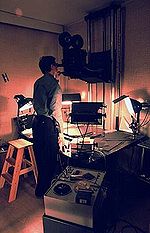
Rostrum camera
Encyclopedia

Movie camera
The movie camera is a type of photographic camera which takes a rapid sequence of photographs on strips of film which was very popular for private use in the last century until its successor, the video camera, replaced it...
used in television production and filmmaking
Filmmaking
Filmmaking is the process of making a film, from an initial story, idea, or commission, through scriptwriting, casting, shooting, directing, editing, and screening the finished product before an audience that may result in a theatrical release or television program...
to animate a still picture or object. It consists of a moving lower platform on which the article to be filmed is placed, while the camera is placed above on a column. Many visual effects can be created from this simple setup although it is most often used to add interest to static objects. The camera can for example traverse across a painting, and using wipes and zooms, change a still picture into a sequence suitable for television or movie productions.
The controls of the camera differ considerably from those of a regular motion picture camera. The key to its operation is one or more frame counters. These enable the camera operator to roll the film backwards and forwards through the film gate, and to know exactly which frame is being exposed at a given time. Also key is the way the operation of the shutter is completely independent from the film transport, so a given frame may be exposed a number of different times, or not at all. Very long exposures are also possible, so that title streaks, zooms and other special effects can be created by keeping the shutter open whilst moving the camera head up and down the column; rotating or moving the lower platform from side to side; or doing both at the same time. For some of these types of effects, the artwork may be a transparency which is back lit by a light source below the table surface.
The camera's film gate is also different to that of a regular motion picture camera, in that fixed pins hold each film frame in place while it is being exposed. This 'pin-registered' gate means that the film can be wound backwards and forwards through the camera head many times, but will always return to exactly the same place without any shifts of the film frame. Such precise repeatability is required for multiple exposures, traveling mattes, title superimposition, and a range of other techniques.
The camera is connected to a mechanism that allows an operator to precisely control the movement of the lower platform as well as of the camera head. The lower platform is often referred to as an animation compound table. In a modern setup a computer controls the horizontal, vertical and rotational movements of the compound table, the zoom
Zoom
Zoom is an onomatopoeiac sound that indicates swiftness.Zoom may also refer to:-Technology:* Zoom lens, a lens assembly allowing for adjustable focal length* Digital zoom, an electronic emulation of focal length change...
of the camera head on the column, and the lens bellows.
Early rostrum cameras were largely adapted from existing equipment, but after WWII industry pioneer John Oxberry made some key refinements to the design. His company, Oxberry Products, then went on to produce some of the best-known models, which were used by leading film and animation studios around the world. Other manufacturers included Acme, Forox, Marron Carrel, Mangum Sickles, the German company Crass, and Neilson-Hordell in the UK. Some of these machines were somewhat smaller and more cheaply built than the Oxberry models, but were ideal for general purpose work such as producing titles and copying artwork to film.
In the UK, Ken Morse
Ken Morse
Ken Morse is often described as Britain's leading rostrum camera operator. He is believed to be the most credited cameraman in history...
is well known for his rostrum camera work in TV and film and his name is often seen in the closing credits
Closing credits
Closing credits or end credits are added at the end of a motion picture, television program, or video game to list the cast and crew involved in the production. They usually appear as a list of names in small type, which either flip very quickly from page to page, or move smoothly across the...
of UK productions.
An animation camera
Animation camera
An animation camera, a type of rostrum camera, is a movie camera specially adapted for frame-by-frame shooting animation or stop motion. It consists of a camera body with lens and film magazines, a stand that allows the camera to be raised and lowered, and a table, often with both top and...
or animation stand
Animation stand
An animation stand is a device assembled for the filming of any kind of animation that is placed on a flat surface, including cel animation, graphic animation, clay animation, and silhouette animation....
, used for single frame shooting on film is similar. With a multiplane camera
Multiplane camera
The multiplane camera is a special motion picture camera used in the traditional animation process that moves a number of pieces of artwork past the camera at various speeds and at various distances from one another...
, a 3-dimensional effect can be obtained.

